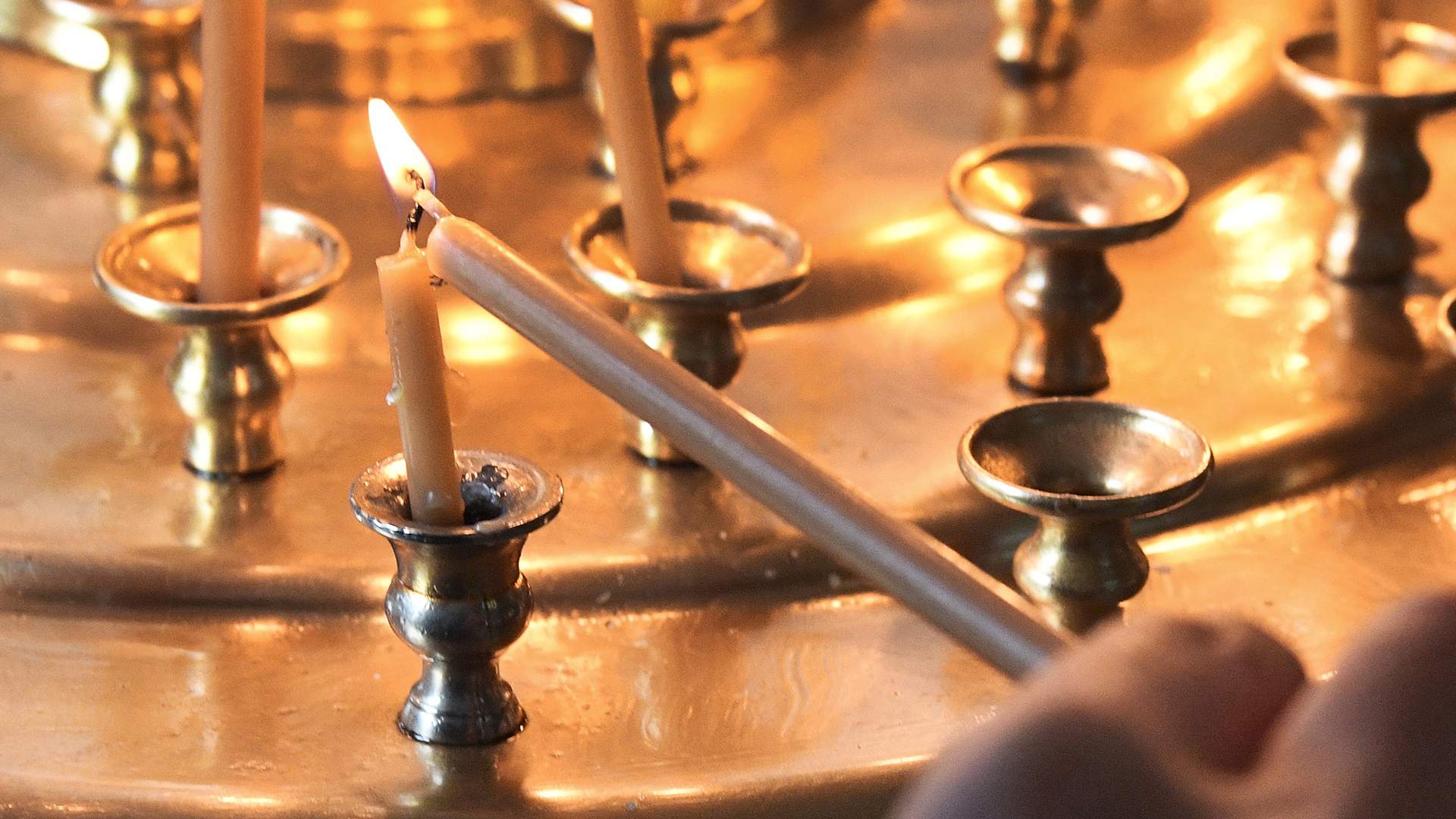- Статьи
- Local news
- The main Orthodox holiday of February - Purification of the Lord: important prohibitions and omens
The main Orthodox holiday of February - Purification of the Lord: important prohibitions and omens

On Saturday, February 15, Orthodox Christians celebrate the Presentation of the Lord, an important bipedal feast commemorating the bringing of Christ from Bethlehem to Jerusalem on the 40th day after his birth. The memorable date symbolizes the meeting of Jesus with the elder Simeon, symbolically the meeting of the Old Testament with the New. According to tradition, on this day candles are consecrated in churches in a special way and important prayers are said. Then the candles are kept at home and lit during prayers on difficult days. Traditions and prohibitions of the important Orthodox holiday - in the material "Izvestia".
Purification of the Lord in 2025: what Church holiday on February 15
Purification of the Lord is one of the most important events in the life of Christ. The date is fixed, so Orthodox believers annually celebrate the Purification of the Lord on February 15.
The feast is dedicated to the meeting (in translation from Church Slavonic "Purification" means "meeting") of the Child Jesus Christ with the righteous Simeon in the Jerusalem temple. This is not only a religious but also a symbolic event that has had a significant impact on Orthodox and Catholic church life over the centuries.
The events of the Presentation of the Lord are described in the Gospel of Luke. According to the Old Testament, every family had to bring their firstborn child to the temple on the 40th day after birth. At the same time, a rite of purification of the mother was performed.

The Blessed Virgin Mary and Joseph, following the law, brought the baby Jesus to the Jerusalem temple to dedicate him to God and offer a sacrifice - two doves or turtledoves, as prescribed by the law of Moses.
They were met in the temple by the old man Simeon the Theotokos, who, according to tradition, had been foretold that he would not die until he had seen the Savior of the world. When he received the Child in his arms, he uttered the prophetic words that have become part of the liturgical texts: "Today you release your servant, O Lord, according to your word, in peace, for my eyes have seen your salvation, which you have prepared in the sight of all peoples.
At the same time, the prophetess Anna, a widow who had been in prayer and fasting for many years, was in the temple. She also recognized in the infant Christ the Savior and began to praise God. The Purification became not only the fulfillment of the Jewish law, but also the meeting of the Old and New Testaments, the moment of realization that the Messiah who came into the world is the light for all peoples.
The Purification of the Lord is celebrated on February 15 (February 2, O.S.), it is among the most important bicentennial feasts, which are dedicated to the earthly life of Jesus Christ.
The main celebration of the Purification of the Lord takes place on the day of the feast, but in the Orthodox tradition there is a feast which lasts until February 22, ending with the celebration of the feast. Purification symbolizes the fulfillment of the Old Testament prophecies about the coming of the Messiah. It also explains the meaning of the meeting of mankind with God through Christ.
The feast played an important role in the formation of the Christian doctrine of Christ as a light to the Gentiles. It emphasizes the divine and human nature of Jesus.
The Purification of the Lord is celebrated in all countries where Christianity is widespread, but with some peculiarities. In Orthodox countries (Russia, Greece, Serbia, Georgia, Belarus, Moldova) there are services, processions, consecration of candles. In Catholic countries (Italy, France, Spain, Poland, Latin America) on this day a solemn mass and consecration of candles are celebrated, as well as the Day of Consecrated Life (the Feast of Monasticism). In Armenia, Purification is known as Trndez, which is accompanied by bonfires and symbolizes the arrival of spring.
The basis of the feast is the Gospel of Luke, which describes the meeting of the Holy Family with the elder Simeon and the prophetess Anna. This story is reflected in iconography, liturgical texts and church tradition.
In art, this feast was often depicted with special solemnity. For example, in Old Russian times, icons of the Purification often featured a large and significant detail - golden or silver leaves symbolizing the light and radiance emanating from the infant Jesus. This emphasized the importance of the event as a moment of illuminating revelation. Professor Sergius Hrameshin of the Slavic Greek-Latin Academy told the publication.
- Purification also has a deep social meaning, symbolizing the meeting of two epochs and generations - the Old Covenant, represented by the righteous elder Simeon, and the New Covenant, embodied in the Child Jesus. In this context, Purification became a time of transferring faith, knowledge and spiritual experience from the older generation to the younger, - concluded the expert.
Traditions of celebrating Purification in the Orthodox Church
On the evening of February 14 in Orthodox churches is celebrated All-Night Vigil, which includes Great Vespers, Litia and Polyelei - solemn glorification. On the morning of February 15, the Divine Liturgy is celebrated, at which passages from the Gospel are read, telling about the bringing of the Child Jesus into the temple.
In the Orthodox Church, the feast of Purification is associated with the consecration of the Purification candles, which symbolize the light of Christ and are used in prayers. These candles, according to popular beliefs, have a special protective power. They are kept in the house and lit at especially significant moments: during a thunderstorm for protection from lightning, during a serious illness for healing, as well as during prayers for the well-being of the family.
In Catholic tradition, this day is known as the Feast of the Purification of the Blessed Virgin Mary and is accompanied by a solemn candlelight procession (Candelaria).
The folk traditions of Purification are largely connected with the idea of the confrontation between winter and spring. In villages this day was considered special, the weather was used to judge the coming year.
In some regions there was a custom to collect water on Purification, because it has healing powers similar to those of the Baptism. Also our ancestors arranged festivities, baked pancakes, which symbolized the sun, and held various rituals aimed at protecting the house and family from evil forces. For example, consecrated candles were placed near icons, and the entrance to the house was decorated with sprigs of mountain ash.
Catholic worship emphasizes the purification of Mary after the birth of Jesus, as well as the prophetic words of Simeon that the Christ Child would become a light to all nations. One of the main parts of the Catholic celebration is the Solemn Mass, during which the faithful make a procession with candles. This custom dates back to the ancient Roman processions, when Christians walked through the streets of the city with burning candles. This procession symbolized the coming of true light into the world.
In Latin America, the holiday is known as the "Day of the Virgin of Candelaria." In Mexico, Spain and some other countries, carnivals and mass festivities are organized.
Among Catholic traditions there is also a widespread custom to dismantle Christmas creches on Purification Day, thus ending the Christmas period. In some European countries on this day housewives bake pancakes. In Germany, France and other countries, this day is associated with many folk omens, which are used to judge the coming season.
Despite the differences in liturgical traditions, the Purification of the Lord in Orthodoxy and Catholicism share a common meaning: the meeting of mankind with God, the recognition of Jesus Christ as the Savior of the world, as well as the symbolic sanctification of life by the light of Christ. This holiday reminds believers of spiritual purification, the need to strive for God and follow His light in everyday life.
Do not do today, on the feast of Purification
On the Purification of the Lord there are a number of prohibitions associated with both religious and folk traditions. On the holiday, any actions that can be seen as disrespect for the church canons are forbidden.
In past centuries, when household chores required a lot of effort, it was forbidden to do housework or construction and repair work. It was believed that working on Purification could attract bad luck, illness and difficulties throughout the year. However, there were exceptions: cooking, caring for children and animals, and doing urgent chores were allowed.
It was strictly forbidden to swear, swear profanely, find out about relationships and conflict. People believed that the quarrels that occurred on Purification could drag on for a long time and lead to serious consequences. It was also believed that negative emotions on this day can attract bad luck in the future.
One should not refuse to help those in need. If a person is approached for help, alms or support, he must respond, otherwise he may lose God's grace. On this day it is important to show kindness, compassion and generosity.
It is forbidden to guess and engage in any occult practices. Purification is a Christian holiday, and any attempts to look into the future or to conduct magical rituals are considered a sin. People used to say that on Purification you could "close the road to happiness" if you practiced witchcraft or turned to otherworldly forces.
In the old days it was believed that traveling on this day could end badly or lead to misfortune. The people even said: "Who is on the road in the Purification - to that on the road trouble". If the trip is inevitable, it is recommended to read a prayer before the road and take with you a consecrated candle or an icon.
It is not recommended to lend money or borrow money yourself. It was believed that in this way you can "give away" your happiness and well-being. This prohibition is connected with the belief that on Purification the foundation for the whole year is laid, and financial losses can affect the future prosperity.
It is also forbidden to leave the house without protection. People believed that on this day the evil force is especially active, so the house should be protected with the help of church candles, sprinkling with holy water and prayers.
The main rule of Purification is to spend the day in gratitude and prayer, to visit the temple. It is important to tune in to the good, avoid negativity and try not to disturb the peace of this holy day.
Folk omens today, February 15
It is believed that if the weather on Purification is frosty and clear, it means that spring will be late and cold. It was said: "If it is frosty on Purification, spring will be late, but friendly". If the day was cloudy and it was snowing or raining, it meant that warmth would come soon. People believed: "If there is a drop on Purification, spring will be early and summer will be warm".
If a strong wind blew on February 15, it foreshadowed a stormy summer, possible hurricanes and bad weather. If the wind changed direction sharply, it was believed that spring would be unstable, with sharp temperature changes. If the sun set in the clouds on Purification, it promised a rainy spring and summer.
The snow that fell on this day was considered special. It was collected and stored, as they believed that it had healing properties and helped with illnesses. Women washed their faces with melted snow to preserve their youth and beauty.
People believed that if you saw bright stars on the night of February 15, it heralded a good harvest. If the night was starless and cloudy, the year was expected to be hard.
Another omen concerned animals. If livestock on February 15 behaved restlessly, it portended sudden changes in the weather.
Purification was considered a day when you can look into the future. Girls carefully watched who would be the first to enter the house. If it was a man - the year promised good luck, if it was a woman - there were difficulties ahead.
Переведено сервисом «Яндекс Переводчик»










